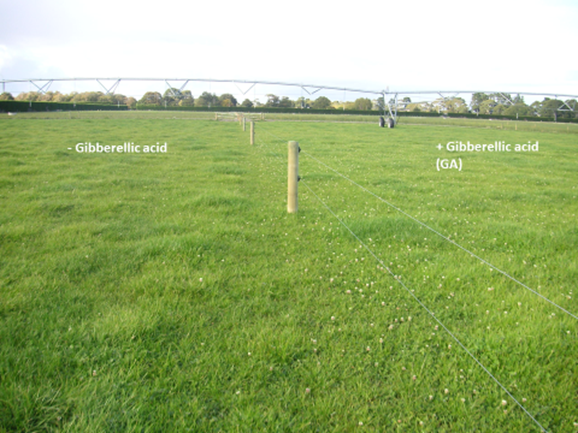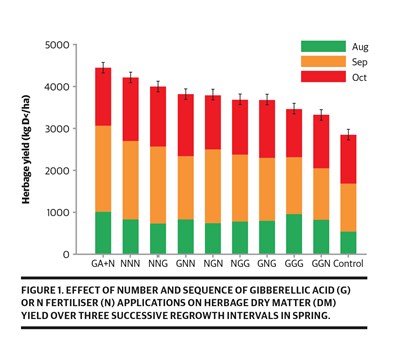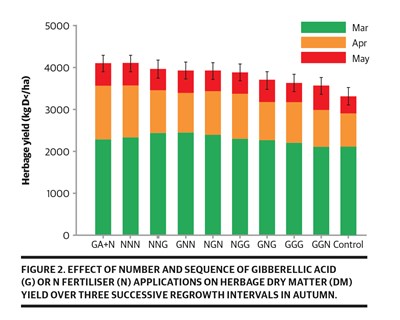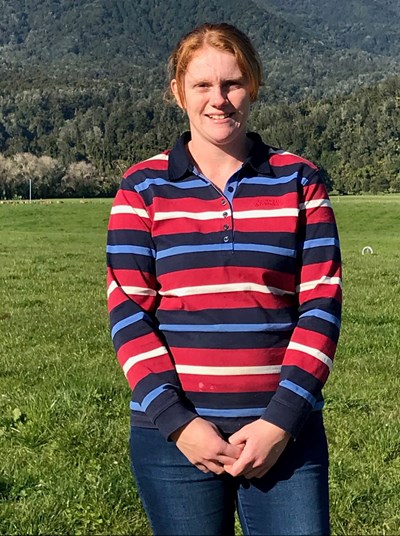Monday, 9 August 2021
Can gibberellic acid substitute nitrogen fertiliser?
As farmers seek new ways to maintain pasture production and feed supply under ‘capped’ nitrogen (N) fertiliser, alternatives such as gibberellic acid (GA) should be explored. As part of a series of experiments exploring opportunities to use GA in dairy farm systems, Lincoln University PhD student Melanie Miller asked questions about the timing and application rate of GA and whether farmers can partially substitute N fertiliser applications for GA to maintain feed supply. Melanie’s research is supervised by Dr Racheal Bryant and Professor Grant Edwards.
Gibberellic acid (GA) is a naturally occurring plant growth hormone that responds to environmental signals such as light and temperature and is part of a signalling pathway that leads to the “switching off” of dormancy. This in turn triggers a response for leaf and stem elongation by mobilising root reserves. Commercial forms of GA, when applied to pasture, can improve herbage production particularly in autumn, winter and early spring when natural levels of GA are low.
The following studies, conducted at Lincoln University investigated:
- The use of GA in place of N fertiliser in late lactation and the effects on pasture and milk production
- The use of single or multiple GA applications in place of N fertiliser
- Timing of GA applications in spring and autumn.
Substituting N fertiliser with GA in late lactation on dairy cow production
Autumn N fertiliser application is an important tool on many farms for lifting average pasture cover, improving animal condition, and reaching production goals for the season before drying off. Autumn is also an important time of year for feed supply, with potentially reduced plant growth and N uptake. Depending on the season, some farmers may have already reached their N limits under the N-190 cap.
Two late lactation grazing studies were carried out to investigate the effect of using GA or N to manage feed supply in late lactation. In the first study we compared GA (8g GA/ha) with an N fertiliser control (50kg N/ha) which was applied to perennial ryegrass and white clover pasture in March and grazed by lactating dairy cows four weeks later in April. The GA-treated pastures had more clover than N treated pasture (18.7% vs 7.4%, respectively) but herbage yield was similar. At the same allocation of pasture DM, there was no effect of GA on milk yield (14.4L/day) or composition (1.45kg MS/day) compared with N fertiliser. To try to combat excess dietary N in late lactation we hypothesised that GA would reduce herbage N compared with N fertiliser. However, because GA stimulated clover growth, applying GA did not reduce N intake of grazing cows compared to those grazing N fertilised pasture.
Our next grazing study was later in autumn and used an area of the farm where there was very little clover under the effluent irrigation. We applied N (50kg/ha) and GA (8g/ha) or no treatment (control) in April and grazed the treated areas four to six weeks later in May, when herbage mass was 3,000kg DM/ha (estimated from plate meter, kg DM/ha = 140*compressed height +500). In that study we found, compared to the control, there was no effect of N or GA treatment on milk yield (14.6L/day) or composition (1.42kg MS/day) largely as a result of there being no difference between treatments for herbage yield. We may not have seen a response because of the long regrowth interval (GA-treated pasture should be grazed within three to four weeks to capture the effect), and possibly because base soil N from effluent paddocks was adequate to meet slow autumn growth.
Substituting annual N fertiliser on dry matter production
We asked how many N fertiliser applications we could replace before reductions in pasture production became evident. To test this, we conducted a ‘cut and carry’ plot study for two years where we replaced one, two or three N (25kg N/ha) applications with GA (8g GA/ha) in spring and autumn (Tables 1 and 2). Yield cuts were taken after an average regrowth interval of four weeks between August and May.
We also wanted to know whether there would be an effect on herbage yield if the replacement GA occurred in the first, second, or third grazing rotation in those seasons. These questions acknowledge the increasing (spring) or decreasing (autumn) daylength and temperature. In both years the first of the three applications were applied in August and March, and treatments were labelled according to the order with which the product was applied at each of the three application dates, e.g. GNN means that GA was the first application followed by two N applications. We compared these with three controls, 1. No N or GA (control), 2. N at all harvests throughout the year (NNN) and 3. GA and N together at all harvests throughout the year (GA+N).

Dry matter values followed by the same subscript are not significantly different.

All treatments had better dry matter production compared to the control (13.6t DM/ha). Although there was a response to treatments immediately after application, there was no statistical effect of rate of GA (i.e. 0, 16, 32, 48 or 80g GA/ha/year) on annual herbage yield (mean, 16.1 ±0.84t DM/ha). On the other hand, there was a positive relationship between N fertiliser rate (i.e. 0, 100, 150, 200 and 250kg N/ha/y) and annual herbage yield, with the most pasture produced when N was applied at 250kg N/ha/y (mean, 17.1±0.04t DM/ha; NNN and GA+N).
Differences in annual yield were most influenced by differences in herbage yield in spring. The importance of N fertiliser is evident with both GA+N and NNN having similar and highest yields in spring (Table 1). As N was increasingly substituted by GA, yields declined. We did not find a consistent effect of timing of GA in spring.
In autumn, we found that using GA in May produced a similar herbage yield as the N treatment, suggesting that there was no yield penalty by substituting N with GA at this time. Across the three regrowths between April and May there was no difference in cumulative herbage yield for the autumn period (means for three months across two years) for any of the treatments that used GA and N (Table 2).
Is GA a substitute for N fertiliser?
It is likely that a response to GA will occur in late autumn and early spring when temperature or daylength are limiting pasture growth. However, as discovered in the second grazing study, to capture the benefits of GA the pasture should be grazed within three to four weeks of regrowth.





